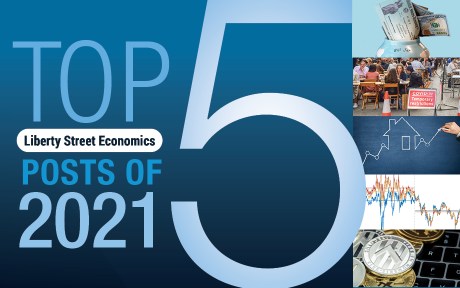
New York Fed researchers tackled a wide array of topics on Liberty Street Economics (LSE) over the past year, with the myriad effects of the pandemic—on supply chains, the banking system, and inequality, for example—remaining a major area of focus. Judging by the list below, LSE readers were particularly interested in understanding what comes next: the most-viewed posts of the year analyze households’ use of stimulus payments, the implications of lockdown-period savings, the risk of a new housing bubble, the compression of the breakeven inflation curve, and the potential roles that central banks could play in the digital currency sphere. As the year draws to a close, take a look back at the top five posts of 2021.

Having reported evidence on how households used their first economic impact payments (first issued in mid-April 2020), the authors examine how households allocated funds from the second round of stimulus checks (first issued at the end of December 2020) and investigate how they planned to use the third round (authorized in March 2021). They find a remarkably stable pattern over the three rounds of stimulus payments: an average marginal propensity to consume of around 26 percent, with most of the funds put toward saving and debt payments. (April 7)
By Olivier Armantier, Leo Goldman, Gizem Koşar, and Wilbert van der Klaauw

How the U.S. economy emerges from the COVID-19 pandemic depends in part on what will happen to the trillions of dollars in “excess savings” that U.S. households have accumulated since March 2020. The authors argue that these savings are not that excessive when considered against the backdrop of the unprecedented government interventions adopted over the previous year in support of households. Further, they make the case that these savings are unlikely to generate a destabilizing surge in demand post-pandemic. (April 5)
By Florin Bilbiie, Gauti Eggertsson, Giorgio Primiceri, and Andrea Tambalotti

During the pandemic, house prices have increased even faster than they did in the period leading up to the 2007 financial crisis, stoking concern that another dangerous housing bubble is developing. The authors take a closer look at the run-up in home prices; their geographic breakdown of the data indicates that we are not seeing a simple repeat of the early 2000s. (September 8)
See also the follow-up post: “If Prices Fall, Mortgage Foreclosures Will Rise.”
By Andrew Haughwout and Belicia Rodriguez

Breakeven inflation—the difference in yields between a nominal Treasury security and a Treasury Inflation-Protected Security of the same maturity—is closely watched by market participants and policymakers alike. Scrutinizing the dynamics of breakeven inflation rates, the authors highlight a substantial downward shift in level as well as a marked flattening of the breakeven inflation curve. Evident for a number of years, this pattern has persisted through the pandemic. (March 22)
By Richard K. Crump, Nikolay Gospodinov, and Desi Volker

Recent developments in payments technology raise important questions about the role of central banks in the digital currency sphere. The authors consider two ways that a central bank could choose to become involved with digital currencies—by backing stablecoins or by issuing their own digital currencies—and discuss some implications of these potential choices. (June 23)
By Tobias Adrian, Michael Lee, Tommaso Mancini-Griffoli, and Antoine Martin
How to cite:
“Stimulus, Savings, and Inflation: The Top Five Liberty Street Economics Posts of 2021,” Federal Reserve Bank of New York Liberty Street Economics, December 22, 2021, https://libertystreeteconomics.newyorkfed.org/2021/12/stimulus-savings-and-inflation-the-top-five-liberty-street-economics-posts-of-2021.html.
Disclaimer
The views expressed in this post are those of the author(s) and do not necessarily reflect the position of the Federal Reserve Bank of New York or the Federal Reserve System. Any errors or omissions are the responsibility of the author(s).










 RSS Feed
RSS Feed Follow Liberty Street Economics
Follow Liberty Street Economics